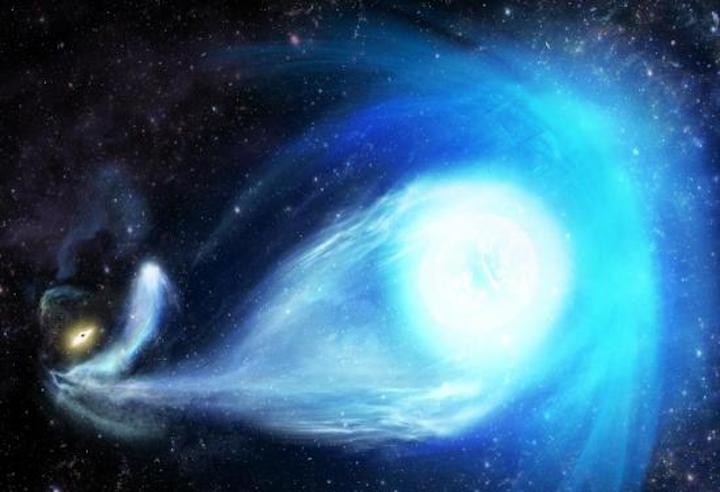14.11.2019

Pasadena, CA—A star traveling at ultrafast speeds after being ejected by the supermassive black hole at the heart of our galaxy was spotted by an international team of astronomers including Carnegie’s Ting Li and Alex Ji. Their work is published by Monthly Notices of the Royal Astronomical Society. Hurtling at the blistering speed of 6 million kilometers per hour, the star is moving so fast that it will leave the Milky Way and head into intergalactic space.
Called S5-HVS1, the star was discovered in the Grus, or Crane, constellation by lead author Sergey Koposov of Carnegie Mellon University as part of the Southern Stellar Stream Spectroscopic Surveyled by Carnegie Princeton Fellow Li. It was moving 10-times faster than most of the stars in the galaxy.
“The velocity of the discovered star is so high that it will inevitably leave the Galaxy and never return,” said co-author Douglas Boubert of the University of Oxford.
High-velocity stars have been a source of great curiosity for astronomers since their discovery two decades ago. Because S5-HVS1 is moving so quickly and passed relatively close to Earth—29,000 light-years, which is practically next door by astronomical standards—it presented an unprecedented opportunity to better understand these phenomena. Due to these unique circumstances, the researchers were able to trace its journey right back to the center of the Milky Way, where there lurks black hole that’s 4 million times the mass of the Sun.
“This is super exciting, as we have long suspected that black holes can eject stars with very high velocities. However, we never had an unambiguous association of such a fast star with the Galactic Center,” said Koposov. “We think the black hole ejected the star with a speed of thousands of kilometers per second about five million years ago. This ejection happened at the time when humanity’s ancestors were just learning to walk on two feet.”
Thirty years ago, astronomer Jack Hills proposed that superfast stars could be ejected by black holes via a process bearing his name.
“This is the first clear demonstration of the Hills Mechanism in action,” Li said.
“Seeing this star is really amazing”, she added, “as we know it must have formed in the Galactic Center, a place very different to our local environment. It is a visitor from a strange land.”
Originally, S5-HSV1 lived with a companion in a binary system, but they strayed too close to Sagittarius A, the supermassive black hole at the center of the Milky Way. In the ensuing gravitational tussle, the companion star was captured by the black hole, while S5-HVS1 was thrown out at extremely high speed.
“My favorite part of this discovery is thinking about where this star came from and where it's going,” said Ji. “It was born in one of the craziest places in the universe, near a supermassive black hole with lots of other nearby star friends; but it's going to leave our galaxy and die all alone, out in the middle of nowhere. Quite a fall from grace.”
The initial discovery was made on the Anglo-Australian Telescope and coupled with observations from the European Space Agency’s Gaia satellite, which allowed the astronomers to reveal the full speed of the star and its journey.
“The observations would not be possible without the unique capabilities of the 2dF instrument on the AAT,” said Daniel Zucker, an astronomer at Macquarie University in Sydney and a member of the S5 Executive Committee.
“I am so excited this fast-moving star was discovered by S5,” added Kyler Kuehn of Lowell Observatory and another member of the S5 Executive Committee. “While the main science goal of S5 is to probe the stellar streams—disrupting dwarf galaxies and globular clusters—we dedicated spare resources of the instrument to searching for interesting targets in the Milky Way, and voila, we found something amazing for ‘free.’”
Captions: Above Image - An artist’s concept of the ultrafast star S5-HSV1, which was ejected from the Milky Way by the supermassive black hole at the galaxy’s center. Illustration by James Josephides, courtesy of Swinburne Astronomy Productions. Video & Top Left Thumbnail - An artist's impression of the ejection mechanism by the supermassive black hole. Video by James Josephides, courtesy of Swinburne Astronomy Productions.
__________________
This work was supported by the U.S. National Science Foundation, a Heising-Simon’s Foundation grant, a Magdalen College Fellowship by Examination, the Rudolf Peierls Centre for Theoretical Physics NASA Hubble Fellowship grants, the Australian Research Council Discovery Project grants, and the Australian Research Council Centre of Excellence for All Sky Astrophysics in 3 Dimensions.
This work has made use of data from the European Space Agency’s Gaia Mission that was processed by the Gaia Data Processing and Analysis Consortium Funding for the DPAC has been provided by national institutions, in particular the institutions participating in the Gaia Multilateral Agreement.
The Carnegie Institution for Science (carnegiescience.edu) is a private, nonprofit organization headquartered in Washington, D.C., with six research departments throughout the U.S. Since its founding in 1902, the Carnegie Institution has been a pioneering force in basic scientific research. Carnegie scientists are leaders in plant biology, developmental biology, astronomy, materials science, global ecology, and Earth and planetary science.
Quelle: Carnegie Institution for Science
